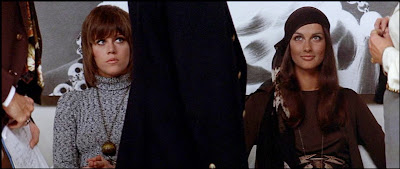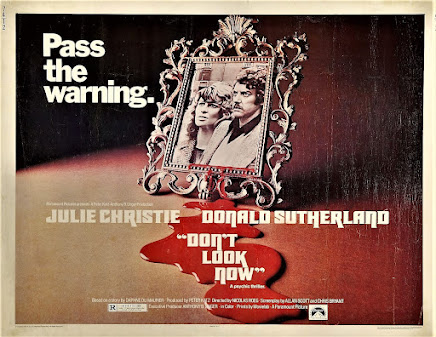Smart movies are hard to come by. Smart remakes…near
impossible. Why?
Well, maybe it’s because Hollywood Hollywood Hollywood
Wholly motivated by a studio’s desire to repeat an earlier triumph and capitalize on brand recognition without having to break a sweat, most remakes are cynical, dumbed-down
affairs tricked-up with new technology and a paucity of inspiration. The
lazier, more arrogant cousin of the sequel, remakes (which, by definition,
presume an improvement over the original) have been responsible for some of the
most painful moviegoing experiences I’ve ever had; e.g., The Stepford Wives (2004), The Haunting (1999), and The Women (2008). Just to name a
few.
Yet, as if to prove
the rule by exception, every now and then, when a remake is inspired by an idea
rather than an accountant’s ledger, the results can be surprising, fresh, even
transcendent. Such is the case with Phillip Kaufman’s shrewd and
remarkably effective remake of the 1956 sci-fi/horror classic, Invasion of the Body Snatchers.
 |
| Donald Sutherland as Matthew Bennell |
 |
| Brooke Adams as Elizabeth Driscoll |
 |
| Jeff Goldblum as Jack Bellicec |
 |
| Veronica Cartwright as Nancy Bellicec |
 |
| Leonard Nimoy as Dr. David Kibner |
The timeless appeal of Invasion of the Body Snatchers
(it’s been remade at least two other times) may have a lot to do with the fact
that we’re a culture which clings to the notion of individuality in the
abstract, yet values conformity in the concrete. Even a cursory glimpse at the
“comments” section of any Internet news site reveals that tolerance for
opposing points of views and ways of life is not exactly America
WHAT I LOVE ABOUT THIS FILM
What makes this Invasion of the Body Snatchers such a
chilling delight is how acutely, and with such perceptive wit, it captures the mood
and preoccupations of a particular point and place in time, and uses it to
breathe fresh life into a familiar horror tale. The late Ira Levin (with both Rosemary’s Baby and The Stepford Wives) was a master at this sort of thing: creating
tension out of tapping into the core anxieties lying at the center of a shifting
cultural climate.
Instead of the small town setting of the original, the 1978
film makes the most of its “Me Decade” angst and takes place in that most
defiantly individualistic of American cities; San Francisco. Which is,
conceptually speaking, perfection personified. Where better to rage a war
against conformity than a city which prides itself on being a haven for the
eccentric, the unique, and the idiosyncratic.
For those too young to have experienced the '70s firsthand, Invasion
of the Body Snatchers is an affectionate, but nonetheless spot-on, skewering
of a certain West Coast sensibility. I was attending an arts college in San Francisco
The San Francisco of Invasion of The Body Snatchers is the post-"hippie movement" San Francisco
As in all times of social realignment, unacknowledged social anxiety and unease is part of the adaptive cultural landscape. It
makes sense to me that in a city as welcoming of change as San Francisco
This barely perceptible nervousness is precisely what
director Phillip Kaufman and screenwriter W.D. Richter seize on in Invasion of
the Body Snatchers to provide a contemporary kick to the sci-fi, body-switching
horror. The threat appears to come from deep space, but when it comes down to
it, what’s most frightening about the whole body-snatching idea is the
possibility that what we most cling to in an interdependent way among friends
and loved ones (our individuality), is what is least valued about us from a societal
perspective.
It hardly feels unintentional that the pod people taking
over San Francisco
PERFORMANCES
It always puzzles me the way so many directors of horror and
suspense films overlook the obvious fact that the effectiveness of any horror
film rests in whatever investment the audience has in the fate of the
protagonists. Take time to flesh out the characters and there’s no telling how
far an audience will go with your premise.
This is especially true with a film whose plot pivots on that
intangible quality known as “humanity.” Invasion of the Body Snatchers appears to have been cast with an eye
towards emphasizing the idiosyncrasies of its stars, and it makes a world of
difference in how we respond to all the genre trappings of chases, close calls, and suspicious red herrings. Donald Sutherland, sporting the same curly locks
from 1973's Don’t Look Now, has always been a kind of goofy, off-beat
leading man. He’s not the lantern-jawed, hero type, so he comes off a believably
strong, yet vulnerable enough for you never to be quite sure if he’s up to the
task at hand.
As good as Adams
and Sutherland are (and Adams is amazing), the prizes have to go to Jeff
Goldblum and Angela Cartwright. As just kind of couple you’d expect to find in
San Francisco (they run a mud-bath establishment; he’s a poet, she’s one of
those espousers of crackpot theories who nevertheless always sounds more sane than the
people around her). They are a hilarious and touching pair, and I daresay that
without their contribution, as excellent a film as Invasion of the Body
Snatchers is, it wouldn’t soar the way it does.
And let’s not leave out Leonard Nimoy. I’ve never been a fan
of Star Trek and no doubt I have a
minimal awareness of his gifts as an actor, but I must say his role as the infuriatingly
logical psychologist is an inspired bit of casting. Audiences were never likely
to shed their image of him as Spock, so I like that the film intentionally
makes use of our predisposed sense of him in a way that doesn’t intrude, but
rather enhances.
Missed Opportunity or Cultural Sensitivity?
Perhaps it’s a sign of Kaufman’s good taste, but as a gay
man, I find it hard to imagine how a film about human cloning set in San Francisco
could resist the impulse to include a scene on Castro Street; home of the “Castro
Street Clone.” For the uninitiated, The Castro is a gay district in San
Francisco where (at least during the '70s) free-thinking gay men willfully abandoned
all personal individuality so as to look identical to one another. Sporting identical
mustaches, haircuts, clothing, and physiques, the Castro Street Clone was a
city mainstay, as identifiable and generic to San Francisco as the Transamerica building. To poke fun at a subculture's need to unify by obliterating differences seems right in line with what the film sought to lampoon.
And yet, thinking back, I recall with great sadness that Invasion
of the Body Snatchers was released
about a month after the murder of openly-gay San Francisco Supervisor Harvey Milk, and the murder of Mayor George Moscone. Under these circumstances there would have been no
place in the film for a reference of this nature. I might have this wrong, but I even seem to
remember that a jokey line of dialog Donald Sutherland speaks to psychologist
Nimoy (“The Mayor’s a patient of yours, isn’t he?”) may have been temporarily
cut out of sensitivity.
In any event, it was strange watching a movie with so many
scenes taking place at its City Hall. San
Francisco felt like a very scary place at the time, and, as one might imagine,
that tragic real-life event—auguring a mounting intolerance and conservatism in
the city known for its liberalism—only made watching Invasion of the Body Snatchers
an even more unsettling experience than it already was.
 |
| "It was like the whole city had changed overnight." |
THE STUFF OF DREAMS
I don’t know if director Phillip Kaufman is an admirer of
Roman Polanski, but Invasion of the Body Snatchers is a film I’m certain Polanski would
appreciate. From the very first frames there is attention paid to establishing
an atmosphere of ever-escalating paranoia and claustrophobia. Every shot contains something—whether in the foreground or distance—which supports these themes. Plants are in almost every shot, sometimes crowding the frame creating a small
space of activity for the actors. There’s
a brilliant sense of danger taking place beyond the confines of the story we’re
witnessing. People are seen running in the distance, every window seems to have
someone staring out of it. The tension grows to the point that even banal human rituals like flossing take on an ominous air (Elizabeth’s boyfriend is seen flossing in an early scene, later at a secret meeting in Union Square Donald
Sutherland’s character passes a man flossing in public).
Of course, it’s
wonderful that all this ambiance is piled on and we’re left to fill in many of
the blanks ourselves. The act of which engages us even further and pulls us into the story.
Jack: "Of course it's a conspiracy"
Matthew: "What is?"
Jack: "Everything!"
Nancy: (recoiling from a lifesize pod replica of her husband) "Jack, don't touch it! You don't know where it's been!"
Jack: "Who are you calling?"
Matthew: "Washington."
Jack: "What...the CIA? The FBI? They're pods already!"
Nancy: "Well, why not a 'space flower'? Why do we always expect metal ships?"
Jack: "I've never expected metal ships."
Jack: "Of course it's a conspiracy"
Matthew: "What is?"
Jack: "Everything!"
Nancy: (recoiling from a lifesize pod replica of her husband) "Jack, don't touch it! You don't know where it's been!"
Jack: "Who are you calling?"
Matthew: "Washington."
Jack: "What...the CIA? The FBI? They're pods already!"
Nancy: "Well, why not a 'space flower'? Why do we always expect metal ships?"
Jack: "I've never expected metal ships."
After Rosemary’s Baby,
which, to me, is the best horror/suspense film ever made, I have to count Invasion
of the Body Snatchers as one of the
most consistently scary (and fun) thrillers I’ve ever seen. It delivers as
drama, black comedy, sci-fi, and horror.
Although set in a marvelously evoked '70s San Francisco, the
film is so smart that it remains a relevant nightmare-inducer even after all
these years.
Today, with all the pierced, body-inked, automatons walking
around with their earbuds buried in their brains, eyes trained on texting fingers,
with nary a moment of eye-contact or human interaction passed between them, we might be ripe for another remake. But I
think we’d better hurry up. From what I’m seeing there’s not a lot of
individuality left to be fearful of losing.
Copyright © Ken Anderson
























































